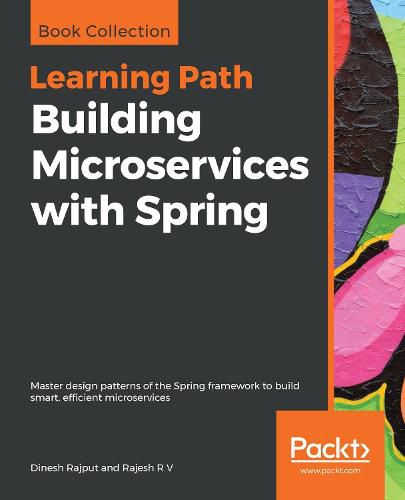Readings Newsletter
Become a Readings Member to make your shopping experience even easier.
Sign in or sign up for free!
You’re not far away from qualifying for FREE standard shipping within Australia
You’ve qualified for FREE standard shipping within Australia
The cart is loading…






This title is printed to order. This book may have been self-published. If so, we cannot guarantee the quality of the content. In the main most books will have gone through the editing process however some may not. We therefore suggest that you be aware of this before ordering this book. If in doubt check either the author or publisher’s details as we are unable to accept any returns unless they are faulty. Please contact us if you have any questions.
Learn and use the design patterns and best practices in Spring to solve common design problems and build user-friendly microservices
Key Features
Study the benefits of using the right design pattern in your toolkit Manage your code easily with Spring’s dependency injection pattern Explore the features of Docker and Mesos to build successful microservices
Book DescriptionGetting Started with Spring Microservices begins with an overview of the Spring Framework 5.0, its design patterns, and its guidelines that enable you to implement responsive microservices at scale. You will learn how to use GoF patterns in application design. You will understand the dependency injection pattern, which is the main principle behind the decoupling process of the Spring Framework and makes it easier to manage your code. Then, you will learn how to use proxy patterns in aspect-oriented programming and remoting. Moving on, you will understand the JDBC template patterns and their use in abstracting database access.
After understanding the basics, you will move on to more advanced topics, such as reactive streams and concurrency. Written to the latest specifications of Spring that focuses on Reactive Programming, the Learning Path teaches you how to build modern, internet-scale Java applications in no time.
Next, you will understand how Spring Boot is used to deploying serverless autonomous services by removing the need to have a heavyweight application server. You’ll also explore ways to deploy your microservices to Docker and managing them with Mesos.
By the end of this Learning Path, you will have the clarity and confidence for implementing microservices using Spring Framework.
This Learning Path includes content from the following Packt products:
Spring 5 Microservices by Rajesh R V
Spring 5 Design Patterns by Dinesh Rajput
What you will learn
Develop applications using dependency injection patterns Build web applications using traditional Spring MVC patterns Utilize the reactive programming pattern to build reactive web apps Learn concurrency and handle multiple connections inside a web server Use Spring Boot and Spring Cloud to develop microservices Leverage reactive programming to build cloud-native applications
Who this book is forGetting Started with Spring Microservices is ideal for Spring developers who want to use design patterns to solve common design problems and build cloud-ready, Internet-scale applications, and simple RESTful services.
$9.00 standard shipping within Australia
FREE standard shipping within Australia for orders over $100.00
Express & International shipping calculated at checkout
This title is printed to order. This book may have been self-published. If so, we cannot guarantee the quality of the content. In the main most books will have gone through the editing process however some may not. We therefore suggest that you be aware of this before ordering this book. If in doubt check either the author or publisher’s details as we are unable to accept any returns unless they are faulty. Please contact us if you have any questions.
Learn and use the design patterns and best practices in Spring to solve common design problems and build user-friendly microservices
Key Features
Study the benefits of using the right design pattern in your toolkit Manage your code easily with Spring’s dependency injection pattern Explore the features of Docker and Mesos to build successful microservices
Book DescriptionGetting Started with Spring Microservices begins with an overview of the Spring Framework 5.0, its design patterns, and its guidelines that enable you to implement responsive microservices at scale. You will learn how to use GoF patterns in application design. You will understand the dependency injection pattern, which is the main principle behind the decoupling process of the Spring Framework and makes it easier to manage your code. Then, you will learn how to use proxy patterns in aspect-oriented programming and remoting. Moving on, you will understand the JDBC template patterns and their use in abstracting database access.
After understanding the basics, you will move on to more advanced topics, such as reactive streams and concurrency. Written to the latest specifications of Spring that focuses on Reactive Programming, the Learning Path teaches you how to build modern, internet-scale Java applications in no time.
Next, you will understand how Spring Boot is used to deploying serverless autonomous services by removing the need to have a heavyweight application server. You’ll also explore ways to deploy your microservices to Docker and managing them with Mesos.
By the end of this Learning Path, you will have the clarity and confidence for implementing microservices using Spring Framework.
This Learning Path includes content from the following Packt products:
Spring 5 Microservices by Rajesh R V
Spring 5 Design Patterns by Dinesh Rajput
What you will learn
Develop applications using dependency injection patterns Build web applications using traditional Spring MVC patterns Utilize the reactive programming pattern to build reactive web apps Learn concurrency and handle multiple connections inside a web server Use Spring Boot and Spring Cloud to develop microservices Leverage reactive programming to build cloud-native applications
Who this book is forGetting Started with Spring Microservices is ideal for Spring developers who want to use design patterns to solve common design problems and build cloud-ready, Internet-scale applications, and simple RESTful services.